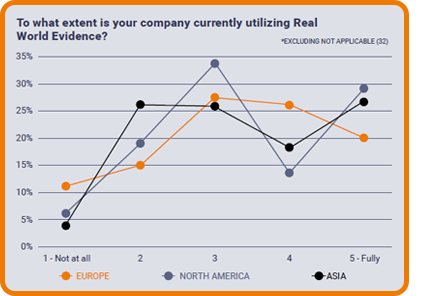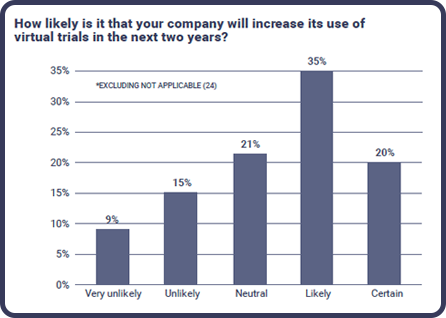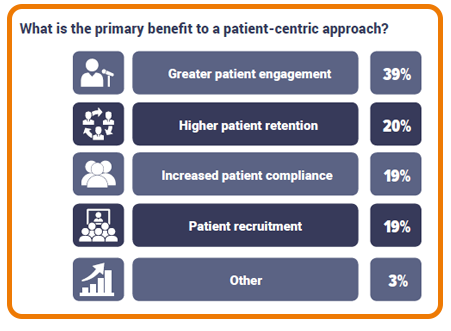Virtual trials and Real World Evidence: The global shift in clinical operations

In May 2019, we conducted a survey of clinical trials professionals on their perspectives of the top challenges and opportunities in the industry today. 214 industry insiders responded from within CROs (29%), pharma and biotech (28%), consultancies, medical device companies and technology providers (26%) investigator sites (6%) and academia (4%).
The respondents told us how their companies were utilizing emerging tools such as virtual trials and Real World Evidence within their clinical trial operations. Here we delve into the results for a closer understanding.
Download the full State of the Industry 2019 report here
Realizing the potential of Real World Evidence
The rich data showed that the concept of utilizing Real World Evidence (RWE) in clinical trials has been well integrated and is likely to rise. Averages from the responses told us that most companies globally were at the halfway point in using this data to its full potential. However, in comparison to those in North America and Asia, more respondents in Europe said their companies were ‘Not at all’ utilizing RWE, and less had responded with ‘Fully’.
Commenting on the results of the survey, Citeline said, “Use of ‘real world’ evidence is increasingly important as industry addresses regulatory agencies’ post-marketing requirements and provides support for new drug applications. Cost and time savings should be realized by utilizing ‘real world’ evidence”.
Getting acquainted with virtual trials
Virtual trials have been long celebrated as an opportunity to reduce clinical trial costs while safeguarding patients. However, when asked what extent at which their organisation was running virtual trials, more than half of European respondents selected ‘Not at all’. Again, this shows Europe behind North American and Asian respondents, of which less than 40% of both had provided the same answer. The lag here is likely due to Europe’s challenges in managing regulations and data standardization across multiple health systems.
Despite the global imbalance, the data does reflect that the general use of virtual trials in clinical trials is still in early days, as organisations are still realizing the benefits and options for implementation. When asked if their companies were currently running virtual trials, between 40% and 55% of respondents in all regions responded with ‘Not at all’.
The data also shows that virtual trials are still high on the agenda for most organisations, as more than half of all respondents said it was either ‘Likely’ or ‘Certain’ that their companies would increase use of virtual trials in the next two years.
Citeline said, “Virtual trials could increase patient participation and provide enhanced efficiencies in data monitoring/analysis. Asia and N. America are ahead of Europe in employing this approach, but virtual trials are expected to increase in the next two years across all regions”.
The benefits of patient-centric approaches
Applying patient-centric approaches are expected to introduce many advantages, especially those powered by technology. However, most respondents said that they recognized having a greater patient engagement as its primary benefit. This could be a result of first-hand experience of having better efficiency as a result of stronger communication with patients. In that case, it is no surprise that this is the highest chosen option, as it can be argued that greater patient is the primary key to achieving higher patient retention, increased patient compliance and easier patient recruitment.
RELATED ARTICLE: Making the patient's life as easy as possible